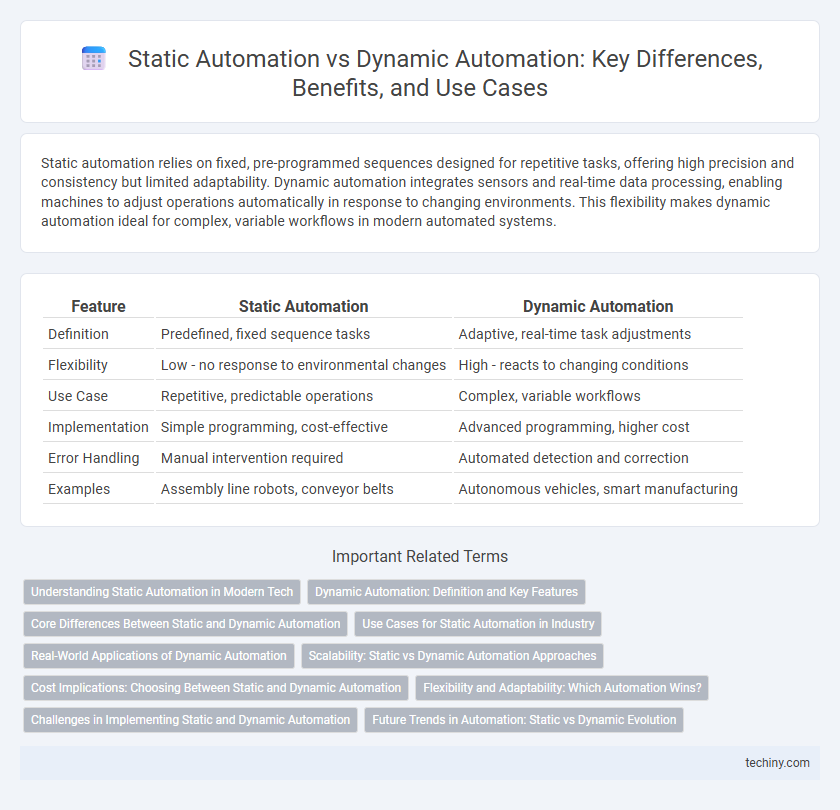Static automation relies on fixed, pre-programmed sequences designed for repetitive tasks, offering high precision and consistency but limited adaptability. Dynamic automation integrates sensors and real-time data processing, enabling machines to adjust operations automatically in response to changing environments. This flexibility makes dynamic automation ideal for complex, variable workflows in modern automated systems.
Table of Comparison
| Feature | Static Automation | Dynamic Automation |
|---|---|---|
| Definition | Predefined, fixed sequence tasks | Adaptive, real-time task adjustments |
| Flexibility | Low - no response to environmental changes | High - reacts to changing conditions |
| Use Case | Repetitive, predictable operations | Complex, variable workflows |
| Implementation | Simple programming, cost-effective | Advanced programming, higher cost |
| Error Handling | Manual intervention required | Automated detection and correction |
| Examples | Assembly line robots, conveyor belts | Autonomous vehicles, smart manufacturing |
Understanding Static Automation in Modern Tech
Static automation involves fixed sequences of operations designed for repetitive tasks, commonly used in manufacturing processes such as automotive assembly lines and packaging. This type of automation relies on predetermined control systems that do not adapt to changes in the environment, ensuring high efficiency and consistency in high-volume production. Understanding static automation in modern technology highlights its role in reducing human error and increasing productivity in stable, repetitive workflows.
Dynamic Automation: Definition and Key Features
Dynamic automation refers to a flexible system designed to adapt and respond in real-time to changing conditions and inputs, enhancing operational efficiency and reducing manual intervention. Key features include real-time data processing, adaptive control algorithms, and the ability to adjust workflows dynamically based on sensor feedback and environmental changes. Unlike static automation, dynamic automation supports continuous learning and optimization, making it ideal for complex and variable manufacturing environments.
Core Differences Between Static and Dynamic Automation
Static automation involves fixed, predetermined sequences of operations designed for repetitive, high-volume tasks with minimal variability, ensuring consistent output and efficiency. Dynamic automation incorporates adaptive systems capable of real-time adjustments based on sensor feedback and changing conditions, enhancing flexibility and responsiveness in complex environments. The core differences lie in static automation's rigidity versus dynamic automation's ability to modify processes to optimize performance and handle variability.
Use Cases for Static Automation in Industry
Static automation excels in industries with high-volume, repetitive tasks requiring minimal variability, such as automobile assembly lines and packaging systems. It optimizes efficiency and consistency by employing fixed sequences of operations tailored for mass production environments. This approach reduces labor costs and enhances product quality through precise, pre-programmed mechanical processes.
Real-World Applications of Dynamic Automation
Dynamic automation adapts in real-time to changing conditions, making it essential for industries like manufacturing, robotics, and autonomous vehicles where flexibility and responsiveness are critical. Unlike static automation, which follows predetermined, fixed sequences, dynamic automation leverages sensors, machine learning algorithms, and feedback loops to optimize processes continuously. This approach enhances efficiency, reduces downtime, and improves safety in complex, unpredictable environments.
Scalability: Static vs Dynamic Automation Approaches
Static automation offers limited scalability due to its fixed programming and specialized equipment, making it ideal for high-volume, repetitive tasks but inflexible to changes. Dynamic automation provides enhanced scalability by utilizing adaptable software and intelligent systems, allowing seamless adjustments to varying production volumes and processes. This scalability advantage makes dynamic automation suitable for industries requiring frequent updates and customization.
Cost Implications: Choosing Between Static and Dynamic Automation
Static automation requires substantial initial investment due to fixed, specialized machinery designed for high-volume, repetitive tasks, limiting flexibility but reducing long-term operational costs. Dynamic automation involves higher variable costs driven by adaptable robotic systems and software, enabling quick product changes and lower downtime but potentially increasing maintenance expenses. Businesses must weigh the upfront capital expenditure of static systems against the ongoing operational and flexibility costs associated with dynamic automation to optimize total cost of ownership.
Flexibility and Adaptability: Which Automation Wins?
Static automation offers high efficiency for repetitive tasks with fixed processes, but lacks flexibility when changes occur in production requirements. Dynamic automation excels in adaptability, easily adjusting to varying workflows and product variations, enhancing responsiveness in complex manufacturing environments. Industries prioritizing customization and rapid shifts favor dynamic automation for its superior flexibility and real-time adaptability.
Challenges in Implementing Static and Dynamic Automation
Challenges in implementing static automation include inflexibility to process variations and high initial setup costs, which limit adaptability in dynamic environments. Dynamic automation faces complexities in real-time decision-making and requires sophisticated AI algorithms to handle unpredictable tasks, increasing development and maintenance demands. Both approaches struggle with integration into existing workflows and ensuring reliability under changing operational conditions.
Future Trends in Automation: Static vs Dynamic Evolution
Future trends in automation highlight a shift from static automation systems, characterized by fixed programming and repetitive tasks, to dynamic automation that leverages AI and machine learning for adaptive, real-time decision-making. Dynamic automation integrates IoT devices and advanced sensors to enable flexible production lines and smarter operations, enhancing efficiency and scalability. Industry 4.0 advancements drive this evolution, positioning dynamic automation as a key enabler of next-generation manufacturing and autonomous systems.
Static Automation vs Dynamic Automation Infographic

 techiny.com
techiny.com